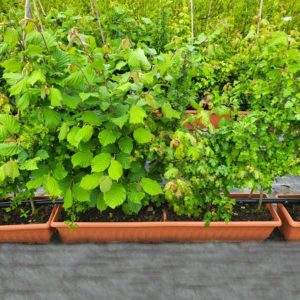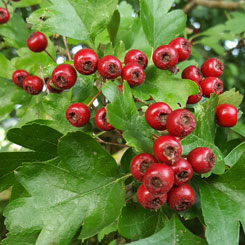Hawthorn | Quickthorn | Maythorn | Crataegus monogyna
Hawthorn (Crataegus monogyna) is a hedging plant that provides year-round interest and a wonderful home for wildlife. It offers white blossom in the spring, bright green leaves tinged with red throughout the spring and summer, and red haws (meaning Old English for fruit) in the autumn. Hawthorn is native to the UK and is deciduous (it loses its leaves in the winter).
Why plant a Hawthorn hedge?
- Fast growing
- Very hardy
- Wind tolerant
- Rich haven for wildlife
- Beautiful spring blossom with scented flowers
- Dense thorny branches ideal for additional security along garden boundaries
- Attractive green and red leaves
- Suitable for most soil types
- Ideal for mixed native hedge
- Young leaves, flowers and are edible and can be used in herbal remedies
- Haws can be used to make jams and jellies
- A hedging plant native to the UK
How far apart should I plant Hawthorn?
Plant Hawthorn 4 to 5 plants per metre if planting small whips or if planting our instant hawthorn or mixed native hedging troughs, plant one per metre as these are one metre long with 4 to 5 plants in each trough.
Where will Hawthorn grow?
Hawthorn is ideal as a hedge on its own or as part of a mixed native hedge (can be combined with Hazel, Field Maple and many other native species). It can be found growing in hedgerows, woods and heathland and is perfect for wildlife gardens due to the protection and food it supplies for birds and insects. It prefers full sun or partial shade and can grow in most soil types but does not tolerate very wet soil. It very hardy and can be grown in all parts of the UK, even on exposed sites with cold winds and where the temperature drops below -20°C.
What type of soil does a Hawthorn hedge need?
Hawthorn will grow in any free draining soil and is ideal as hedging or in wildlife gardens. They tolerate most soil types including acid and alkaline soil.
How tall will Hawthorn grow?
Mature Hawthorn trees can grow up to 15-30ft in height and width but it can be kept to any height of hedge if trimmed once a year.
How fast will Hawthorn grow?
Hawthorn can grow at a rate of up to 45-60cm (18-24 inches) per year making them ideal as privacy hedging and to provide dense habitats for wildlife.
When can I plant Hawthorn?
We sell mature hedging plants in troughs and pots online ready to plant at any time of the year. We also sell bare-root plants (whips) at our Greenshutters Garden Centre in Somerset (if you live locally and would prefer to start your hedge off from smaller hedging plants).
How often would I need to trim/prune a Hawthorn hedge?
Hawthorn is quite fast growing so needs to be trimmed once a year, after it flowers or in the autumn to maintain as a hedge. Hawthorn can grow into large trees if left untrimmed. It should not be pruned between March and August to avoid disturbing nesting birds and wildlife.
Additional Information about Hawthorn
According to the Woodland Trust, common Hawthorn is second only to Oak trees for its benefits to wildlife. It can support more than 300 insects, as well as providing food for dormice, bees and birds. The flowers, fruit and leaves are all edible when young and can be used for a number of herbal remedies. The wood can be used for making furniture and tools and burns well as firewood and charcoal.
Alternative names
Thorn, Quickthorn, May Blossom, May Thorn, May Flower, Crataegus monogyna
Botany and Origins of Hawthorn
Hawthorn is a member of the Rosaceae family. Deciduous trees and shrubs have spiny branches, lobed leaves and sprays of white spring flowers in spring followed by red fruits in autumn. It can be found in Northern Europe, North Africa and South West Asia
Crataegus comes from the Greek kratos meaning “strength” and akis “sharp”, referring to the thorns of the plants.
Evergreen Native Alternatives to Hawthorn/Field Maple/Hazel
Holly (Ilex aquifolium) is a good option providing glossy green foliage and bright red berries.
Evergreen Non-Native Alternatives
Try Portugal Laurel, Griselina, Pyracantha, Laurel and Photinia Red Robin.
Hazel | Corylus avellana
Hazel is a native hedging plant with broad leaves that provides year-round interest and is ideal for both single species hedging or mixed native hedging. It is deciduous, meaning it loses its leaves in the winter.
Why Hazel?
- Year-round interest
- Attractive yellow catkins in spring
- Good autumn leaf colour
- Suitable for single species or mixed native hedging
- Thrives in most soils and environments
- Shade tolerant
- Supports woodland wildlife
- Produces edible nuts in September and October
- Supports butterflies, ground nesting birds and small mammals
- Tolerant of windy and exposed sites
How far apart should I plant Hazel?
Plant our mixed native hedging troughs one per metre as these have 4-5 plants per trough and are one metre wide.
We recommend planting 4 to 5 Hazel plants per metre. You can mix them with Hawthorn, Field Maple, Blackthorn, Spindle and/or Dogwood to create a mixed native hedge.
What type of soil does a Hazel hedge need?
Hazel thrives well in most free-draining soils, is shade tolerant and suitable for windy and exposed sites. It will not grow in water-logged soils.
How tall will Hazel grow?
Hazel hedges can be kept at any height if pruned once a year. If left untrimmed, a Hazel tree can grow up to 4-8m (12-25ft) in height.
How fast will Hazel grow?
Hazel can grow up to 45-60cm (18-24in) per year depending on conditions making it ideal for dense hedges.
How often would I need to trim a Hazel hedge?
Pruning should be done annually as Hazel hedges are fast growing. Trim in the winter after the birds have eaten all of the fruit and before they begin nesting. In January and February remove any dead wood and suckers, which can be used for staking in the garden, especially for peas.
Additional Information about Hazel
The hazel plant grows straight stems that are flexible and can be twisted into a knot without breaking. They can be used for twisting into plant supports such as peas sticks and screens or hurdles. It was also traditionally popular for making furniture.
In the spring the plant produces attractive yellow catkins which are followed by edible nuts (hazelnut, cobnut or filbert nut).
Hazel can also be coppiced (cut down to the ground) and it will re-grow. This is often done in managed woodlands to encourage wildlife, especially Doormice which do not like to go on the ground but prefer to move around the woodland from branch to branch. The younger branches of Hazel grow back into a dense canopy for them to move around.
The many names of Hazel
Hazel is also know as cobnut or filbert. Its botanical name is Corylus avellana.
Botany and Origins of Hazel
Hazel belongs to the Betulaceae (Birch) family of plants and is native to the UK, Europe, Western Asia and North Africa.
The Benefits of Hazel
A Hazel hedge provides year round interest with its berries, seeds flowers and foliage. This will help attract a wide variety of wildlife from insects and birds and small mammals. The Hazel stems can be used for a number of purposes in the garden involving weaving into screens and using to stake and support a number of tender plants as they grow. If you can harvest the nuts before the squirrels get to them you can use in many recipes or just as a healthy snack.
Alternatives to Hazel
Hawthorn, Field Maple or use them in a mix.
Field Maple | Acer campestre
Field Maple is a native plant suitable for use in a single species hedge or as part of a mixed native hedge. It can be found in woods, scrubs and in hedgerows. After its helicopter seeds have been released from the plant, its foliage turns a rich yellow to provide colour through to autumn. Field Maple is deciduous, meaning it loses its leaves in the winter.
Why Field Maple?
- Fast growing
- UK’s only native maple
- Rich autumn colours
- Suitable for most soils and positions
- Attracts wildlife
- Pollution tolerant
- Good for exposed sites
- Popular in towns and cities
How far apart should I plant Field Maple?
Plant our mixed native hedging troughs 1 metre apart and you will get an instant hedge as these troughs are 1 metre wide.
Plant large individual plants between 3 to 5 per metre in a staggered row to get a thick, dense hedge. They can be mixed with other native hedging plants such as Hawthorn (Crataegus monogyna), Hazel (Corylus avellana) and Holly (Ilex aquifolium).
What type of soil does a Field Maple need?
It will grow in most soils including chalky and coastal environments, but does not do well in waterlogged soil.
Where will Field Maple grow?
Field Maple will grow in sheltered or exposed sites in full sun or partial shade.
How tall will Field Maple grow?
It can be kept as low as 1 metre tall if trimmed once a year but will grow up to mature tree of 8m (25ft) high if left.
How fast will Field Maple grow?
Field Maple is fast growing and can grow between 45-60cm (18-24in) per year.
How often would I need to trim/prune a Field Maple hedge?
Field Maple needs to be trimmed annually; this can be done at any time of the year but avoid trimming a mixed native hedge between March and August because of nesting birds.
Additional Information about Field Maple
Field Maple is a fantastic addition for any gardener looking to attract wildlife; especially ladybirds, hoverfly and birds. Its nectar and pollen, and subsequent fruit provide excellent food sources for birds, bees and small mammals.
The many names of Field Maple
Hedge maple, Common elder
Botany and Origins of Field Maple
Field Maple (Acer campestre) is part of the Soapberry (Sapindaceae) family and is native to the UK. It has a maple-shaped leaf with 5 rounded lobes and forms winged maple fruits and seeds (helicopter seeds).
The Benefits of Field Maple
A vibrantly coloured hedge that turns from green to red to yellow through the seasons. Field Maple attracts diverse array of wildlife and provides interest from spring to winter, when its leaves fall off and reveal the attractive woody stems. Field Maple makes an excellent dense hedge or suitable as part of a mixed native hedge.
Alternatives to Field Maple
Hawthorn, Hazel










